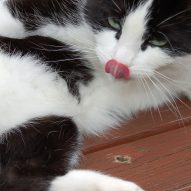Feline Urethral Obstruction: Why is my Cat Licking Down There? | Dr. Justine Lee
 Feline urethral obstruction: Why is my cat licking down there?
Feline urethral obstruction: Why is my cat licking down there?
If you have a male cat, pay heed to his kitty litter habits, as it can be life-threatening if you don’t.
In my book, It’s a Dog’s Life… but It’s Your Carpet, I explain the ever-evasive question: “Why do dogs lick their balls?” (I’m a medical professional, so am allowed to use that word!). Sadly, there’s no smart excuse for it – it’s just because they can. Cats, on the other hand, don’t usually do this just for entertainment value. When you see cats licking down there, chances are it’s because they’re being hygienic. Since your cat can’t use toilet paper, and since you don’t want to wipe for him, it’s all he can do to stay spotless.
However, if your cat is spending too much time “down there,” it’s actually a medical problem, and it warrants a closer look. If his penis is sticking out, then something’s wrong, as cats never show their male parts until they have a feline urethral obstruction (FUO).
A FUO is life-threatening because there’s something blocking your cat from urinating. The urethra, a tube from the bladder to the exterior body (e.g., penis tip) is a narrow diameter, and grit, crystals, mucous plugs, or blood clots can obstruct it, resulting in an FUO. Untreated, a FUO results in toxic kidney poisons building up in the bloodstream. This causes a temporary acute kidney failure, and can cause severe electrolyte or salt abnormalities. Without prompt medical attention, these electrolyte abnormalities can result in a life-threatening cardiac arrhythmia (e.g., abnormal rhythm).
Signs of a feline urethral obstruction include:
- Excessive grooming
- Lethargy
- Crying out (especially when picked up near the bladder)
- Bloody urine (typically small drops throughout the house)
- Inability to urinate for more than twelve to eighteen hours
- Making multiple trips to the litter box with no obvious urine clumps there
- Vomiting
- Straining to urinate (or in your eyes, defecate)
- Howling
- Acting painful
- Squatting to urinate in strange places (like in your tub, on your comforter, or in your large potted plant – “Hello! What do I have to do to get you to take me to a vet?”)
If you notice any of these signs, see your veterinarian or emergency veterinarian immediately. Your cat is doing all he can to make you realize he needs help. Treatment includes sedation (pain medication), having a sterile urinary catheter placed, blood work to monitor electrolytes and kidney function, aggressive IV fluids to flush out the kidneys, and a urinary catheter for a few days to relieve the obstruction.
Some other more benign causes for excessive licking “down there” include irritation to your cat’s penis tip, a bladder or urethral (the tube from the bladder to the tip of the penis) stone, or even having a sterile cystitis. This last one is also called feline lower urinary tract disease (FLUTD), and I’ll describe in my blog in a few weeks. Signs of a FUO are very similar to FLUTD, so when in doubt, bring your cat to a vet to cop a feel of the bladder – it’s the safest and easiest way to make sure your cat stays happy and healthy!
Some tips on how to avoid an expensive FUO visit in the future? First, adopt female cats – it’s rarely a problem in females due to the larger diameter of their urethra. Second, increase the water content in your cat’s diet (e.g., gruel down extra water with canned food; provide a kitty litter water fountain, etc.). Third: kitty litter husbandry. This doesn’t mean that your husband cleans the litter box… it means taking care of the litter box. More on this in the next few weeks…
Have a personal experience with FUO? Any tips for pet owners after your emergency? Do share!
If you have any questions or concerns, you should always visit or call your veterinarian – they are your best resource to ensure the health and well-being of your pets.
As previously published by Dr. Justine Lee on Pet Health Network. Copyright Justine Lee Veterinary Consulting, LLC.
Photo by Facing North East // cc



No Comments
Trackbacks/Pingbacks